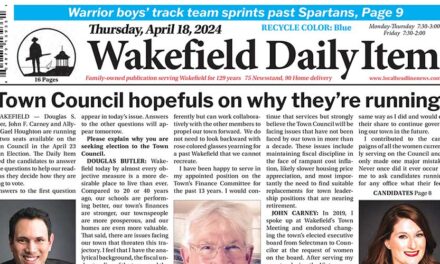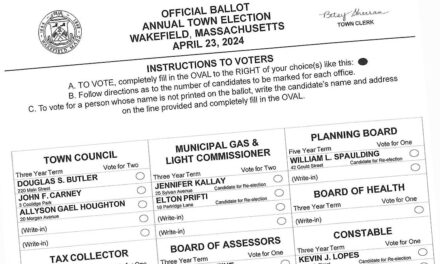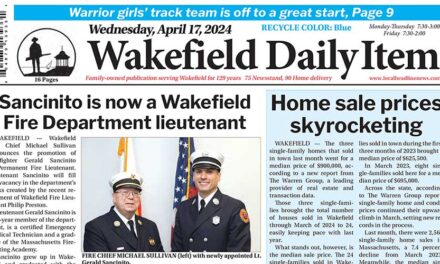Published in the January 20, 2017 edition.
An interesting history of the area’s railroading past was given in Lynnfield recently. We thought we’d share it with you, since Wakefield figured mightily in the story.
By DAN TOMASELLO
Trains and trolleys were the modes of transportation in our area for decades. They’re mainly things of the far past now, but for years the region bustled with the clickety-clack of rail-driven commerce and commuting.
Former firefighter and Lynnfield Selectman Bob MacKendrick on Wednesday brought those days back to life as a small group of Lynnfield residents heard him talk about the small town being home at one time for four different rail lines.
MacKendrick has been hosting a monthly program called Hobbies with Bob at the Senior Center for the past couple of years, where he discusses local history and hobbies that seniors find interesting. He said he developed a love of trains and model trains while growing up in town.
“I have lived in Lynnfield since 1956, so I guess you can say I’m a newbie,” MacKendrick joked.
MacKendrick said the town was home to four different railroads. He said the Salem and Lowell Railroad began being built around 1840, and the Newburyport Branch Railroad opened in 1850. The South Reading Branch Railroad opened in 1850 as well. He also said the town was home to a trolley line that went from Peabody to Wakefield, which MacKendrick believes was part of the Bay State Street Railway. He said there is very little information available about the Bay State Street Railway.
Additionally, MacKendrick gave an overview of the different types of passenger and freight trains that used the four different railroads.
Newburyport Branch Railroad
MacKendrick said the Newburyport Branch Railroad was part of the B&M Railroad that went from Newburyport to Wakefield.
“It was a railroad that came about from the merger of three small companies into one rail line to compete with the Eastern Railroad for service between Newburyport and Boston,” said MacKendrick.
MacKendrick said one of the company’s involved with the Newburyport Branch Railroad was the Danvers Railroad, which began constructing a line from Danvers to the South Reading Railroad and the B&M Railroad in Wakefield in 1853.
“The Newburyport Branch Railroad is the one that goes through the center of town down by the Reedy Meadow Golf Course,” said MacKendrick. “It’s the one they are talking about for the controversial rail trail.”
MacKendrick said the rail line was completed in 1855 and B&M operated the section from Danvers to Wakefield. In 1860, the rail line was leased to the Newburyport Railroad, which took over operating the line and it became the Newburyport Branch. B&M purchased the line in Oct. 1906.
After the Newburyport Branch experienced declines in ridership for a number of years, MacKendrick said passenger travel came to an end in 1959.
“(B&M) then sold it to the MBTA,” said MacKendrick. “Freight service continued between Wakefield and Danvers until about 2001.”
South Reading Branch Railroad
MacKendrick said the South Reading Branch Railroad, later known as the Wakefield Branch, was a short line that went from Wakefield to Peabody. He said the railroad opened in 1850.
According to MacKendrick, the South Reading Branch Railroad was built because the Eastern Railroad had a monopoly.
“What they would do a lot of times is build a railroad to get competition,” said MacKendrick. “It took a lot of Eastern Railroad’s business away because of lower rates.”
MacKendrick said the Eastern Railroad took over the line 1851 as part of a pre-emptive move to prevent B&M from taking over the South Reading Railroad.
“The Massachusetts State Legislature forced the Eastern Railroad to keep the Boston-to-Salem route open via the South Reading Railroad even after they had gone into some other stuff,” said MacKendrick. “South Reading became Wakefield. Cyrus Wakefield built a huge industrial complex that was a rattan factory. He donated a city hall to the town, so they changed the name to Wakefield.”
Salem and Lowell
According to MacKendrick, the Salem and Lowell Railroad ran off the Essex Railroad and went from Peabody to Tewksbury, where it connected to the Lowell and Lawrence Railroad. The Boston and Lowell Railroad took over the rail line in 1858. MacKendrick noted the railroad was often used to transport coal from Salem.
“Many coal trains ran along the Salem and Lowell Railroad to Lowell, Lawrence and points beyond,” said MacKendrick.
MacKendrick said the Boston and Maine (B&M) Railroad gained control of all the railroads in Essex County and most of the rail lines in Middlesex County around 1900.
“All service was suspended between Tewksbury Junction and Wilmington Junction in 1924 and that segment was abandoned by the end of 1925,” said MacKendrick. “Passenger service ended in 1932 and freight service to North Reading ended in 1935. Freight service to West Peabody and South Middleton continued until 1980, and the line between Peabody and West Peabody was abandoned in 1962.”
MacKendrick said the Salem and Lowell Railroad existed because Lowell was an industrial city. He also said the railroad was built because Salem and Boston were rival seaports.
“We don’t think of Salem as being a seaport, but at that time there was a big rivalry as who was going to be the top gun when it came to seaports,” said MacKendrick. “Obviously, Boston ended up winning.”
MacKendrick said the Salem and Lowell Railroad started in Salem, went through Peabody Square and went across Route 128 near the current Northshore Mall. He also said the rail line went down by Su Chang’s in Peabody, ran alongside Lowell Street and went across Route 1. He said the railroad connected with the Newburyport Branch Railroad.
“That line went up to B.B. Chemical on the Middleton-Lynnfield line,” said MacKendrick. “They used to have railroad cars going into B.B. Chemical because there was a lot of business there. It’s now Bostik.”
MacKendrick noted B.B. Chemical used to make glue. While serving in the Fire Department, MacKendrick said the department was forced to respond to the business’ churn room exploded.
“It was highly flammable when they mixed the glue,” said MacKendrick.
MacKendrick said the Salem and Lowell Railroad also cut through land owned by the Lynnfield Center Water District that runs parallel to the Ipswich River.
“It was the first railroad to run through Lynnfield,” said MacKendrick.
Trolley line
MacKendrick said the trolley line that ran through town started at Salem Willows, came through Peabody and went down Salem Street. He also said the trolley line went down Walnut Street and eventually went to Wakefield Square near Omelette Headquarters.
“It tied in with the other lines there,” said MacKendrick.
MacKendrick said trolley lines were “extremely popular from the 1880s to the 1930s.”
“During the summertime, the trolley cars were nice and airy,” said MacKendrick.
In addition to people using trolley lines for commuting, MacKendrick said people used to take trolley lines to places like Salem Willows and other amusement parks called “trolley parks.”
“What happened was all the commuters built homes around the trolley lines so they could have transportation into the city,” said MacKendrick. “But (railroad companies) said they have all these tracks and equipment sitting around on the weekends and at nights, so they decided to extend the line out and build an amusement park. The trolley parks were a pretty big deal.”
While most cities and towns replaced trolley lines with buses, MacKendrick noted some cities kept their trolley lines such as the Green Line in Boston.
“Boston is fortunate because it kept a lot of the trolley lines,” said MacKendrick.
Local resident Sandy Angus said Hudson Bus Lines, which had a garage at the Irving gas station in Wakefield, replaced the Lynnfield trolley line.
Upcoming presentations
MacKendrick said he will be discussing the history of Suntaug Lake next month. The March presentation will be about the history of Route 1 from 1900 to 2017.




